Metamachy
Metamachy is a large Chess variant designed by Jean-Louis Cazaux, which supplements the orthodox Chess pieces with a mix of pieces from regional and historical variants. Its name is derived from Greek, and means "beyond the fight". It solves the problem of the large depth of the board in a way not often encountered in other variants: the double push of Pawns is not just possible on their initial move, but anywhere on the board.
Metamachy has been revealed in 2012. It is one of the rare chess variants to have got a full book dedicated to it. It is written in French and is intitled "Traité Pratique de Métamachie" from J.L. Cazaux (Pionissimo, 2012). It is also described in:
- A World of Chess from J.L. Cazaux & R. Knowlton (McFarland, 2017)
- More Chess & More Than Chess from J.L Cazaux with contributions from P. Rapoport and H.G. Muller (Lulu.com, 2023)
Metamachy can be played on Jocly, with Zillions-of-Games, on Musketeerchess.net, on Chess V and on AI AI platforms. It has an entry on Board Games Geek.
You can also play Metamachy with Game Courier here!
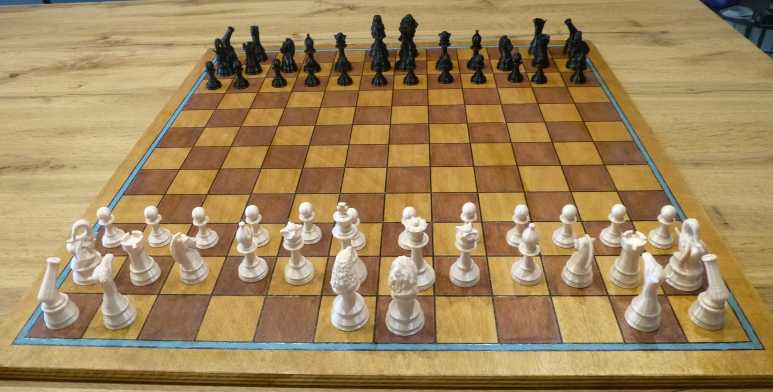
Setup
The initial position is not fixed: the four most-valuable pieces (King, Queen, Lion and Eagle) can be permuted in any desired way, leading to 12 essentially different initial positions (plus their 12 mirror images).
Pieces
The Cannon moves as in Xiangqi: like a Rook without capturing, while capture is only possible with an orthogonal move that jumps over exactly one piece (of either side).
The Elephant can jump directly to the second diagonal square, or step to the first.
The Eagle is a bent slider: its trajectory starts with a diagonal step, and then continues outward orthogonally. The first obstacle in this path blocks any further steps (but can be captured if it is an enemy).
The Lion can directly leap to any square not further than 2 King steps away.
The Camel is an 'elongated Knight', i.e. it can make an (1,3) leap in all eight directions.
The Prince in Metamachy is a Pawn-like piece: like the Pawn it has a non-capturing double push anywhere on the board, and can be captured en passant on the square that this passes through. Otherwise it moves like a King. And like the Pawn it promotes when reaching the last rank. Despite what its name suggests, it has no royal properties.
In addition to its usual move the King has an initial non-capturing leap of two squares in all directions, even the hippogonal ones. With this move it is not allowed to move out of check. Although it is allowed to jump over any piece, it cannot do so if the King could not have been legally moved to the square it jumps over, had that square been empty. The King can reach a square a Knight jump away through both the orthogonally and diagonally adjacent intermediate square, and both these squares must be under attack to prevent the jump. There is no castling in Metamachy.
The Knight, Bishop, Rook and Queen move as in orthodox Chess.
Rules
Normal rules for checking apply: moves that expose their King to capture are not legal, even if that capture would expose the opponent King to capture. The game is thus won through checkmating the opponent.
Stalemate is a draw.
Black determines how King, Queen, Lion and Eagle are put on the squares f12, g12, f11 and g11 before the first move. White then has to put his pieces so that the position is mirror symmetric.
Pawns can capture Pawns and Princes that have just made a double push en passant in the usual way: undoing the second step of the double push, and then capturing it. Note that this can happen anywhere on the board, as the double push is not limited to Pawns and Princes in their initial location. Princes can never capture en passant, even though they can be captured this way by Pawns. Often they would be able to capture a doubly pushed Pawn or Prince with one of their normal capture moves, though.
Pawns and Princes must promote upon reaching the final rank, to Queen, Lion or Eagle. Other choices are not allowed.
Notes
The Cannon is borrowed from Xiangqi, the Camel from Tamerlane Chess, and the Eagle is the 'Aanca' from Grant Acedrex (often referred to a Gryphon in chess variants).
An initial 2-square leap for the King also occurs in Grant Acedrex, but not in hippogonal directions, and it can pass through check there.
The Elephant is inspired by the historic Shatranj piece, but the possibility to also move a single step is a modern addition needed to make the piece interesting enough to warrant its appearance.
The Lion is a weakened version of the Chu-Shogi Lion, lacking the locust-capture power of the latter. In other variants this weakened version is sometimes called Lioness.
Presence on the Internet:
- Video of a game on Youtube
- Discussed on a forum dedicated to dozenal mathematics and recreations
A set of pieces in a "Staunton-style" has been designed to be 3D-printed for playing Metamachy (contact J.L.Cazaux).
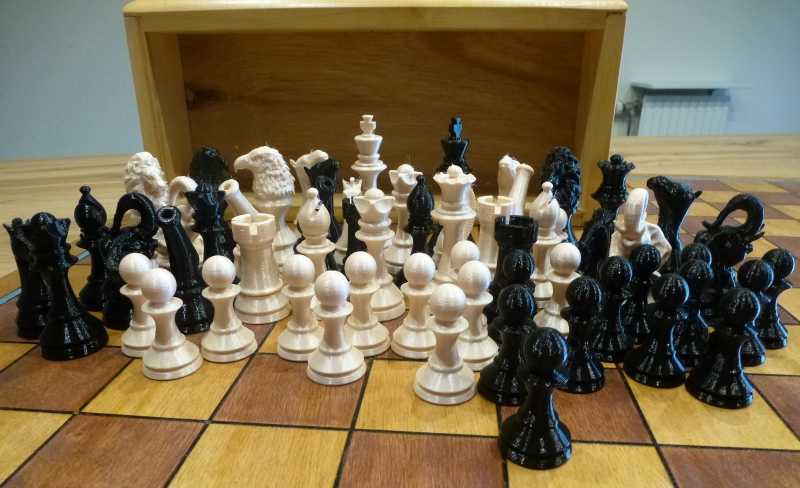
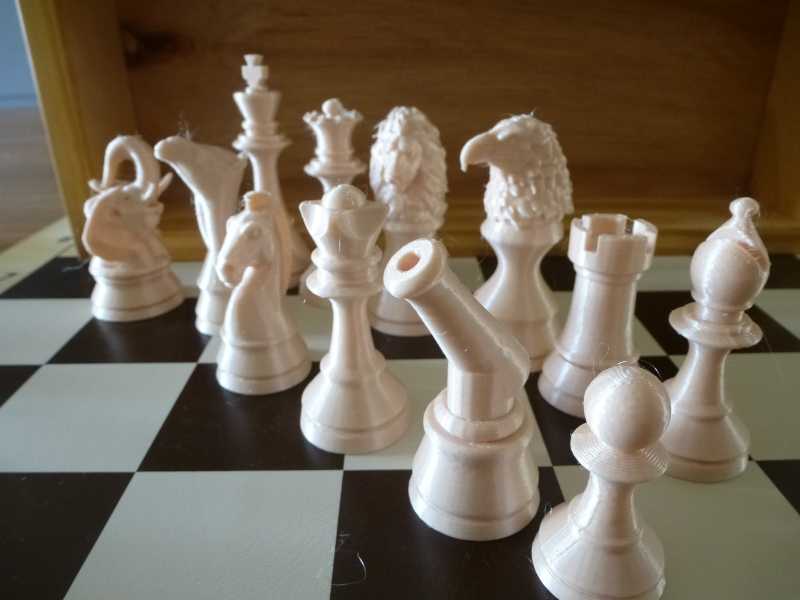
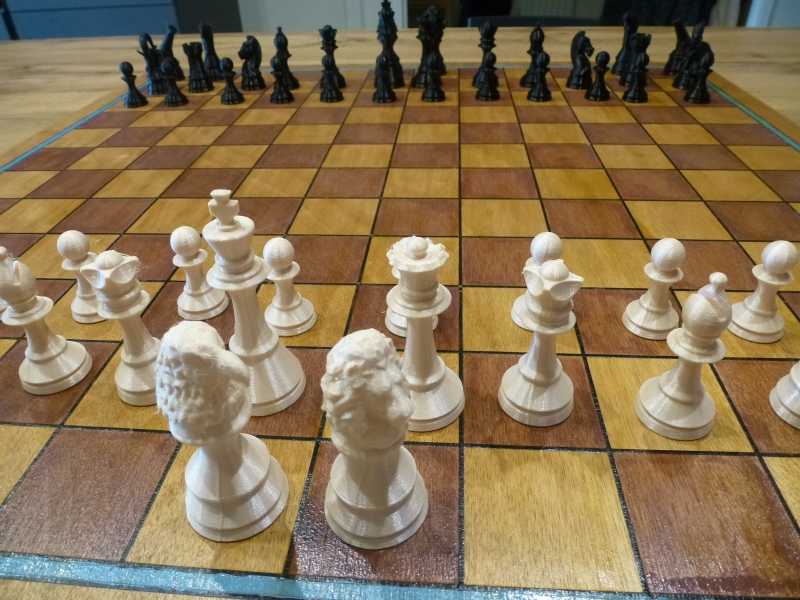
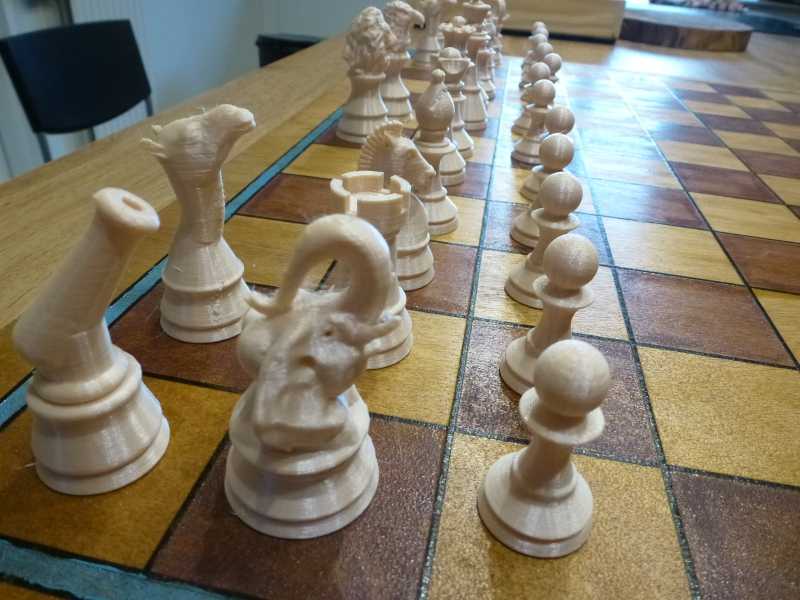
 This 'user submitted' page is a collaboration between the posting user and the Chess Variant Pages. Registered contributors to the Chess Variant Pages have the ability to post their own works, subject to review and editing by the Chess Variant Pages Editorial Staff.
This 'user submitted' page is a collaboration between the posting user and the Chess Variant Pages. Registered contributors to the Chess Variant Pages have the ability to post their own works, subject to review and editing by the Chess Variant Pages Editorial Staff.
Author: H. G. Muller and Jean-Louis Cazaux. Inventor: Jean-Louis Cazaux.
Last revised by Jean-Louis Cazaux.
Web page created: 2017-08-07. Web page last updated: 2020-04-30
